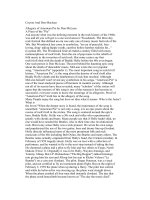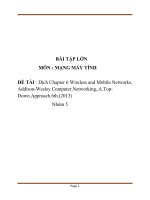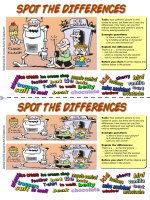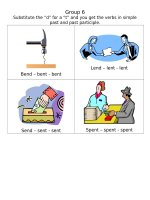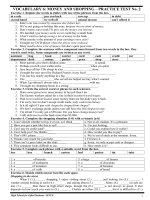WorkbookEdition 6 coyote and fox
Bạn đang xem bản rút gọn của tài liệu. Xem và tải ngay bản đầy đủ của tài liệu tại đây (118 KB, 5 trang )
READTHEORY
Passage
Name________________
Date________________
• Reading Comprehension Assessment
Directions: Read the passage. Then answer the questions below.
Coyote and Fox
According to Hopi legend, Coyote and Fox have never liked each
other. Coyote, who is a famous trickster, will try to get the better of Fox
whenever he can—especially if he can also get a free meal while he’s
doing it.
One day, Fox managed to catch a rabbit. He said. “This is a fine,
fat rabbit. It will make a tasty dinner!”
Fox got some wood and made a fire. He put the rabbit on a stick
and let it roast. “It will take a while until the meat is done,” he said. “I think
I’ll take a little nap while it cooks.”
Now Coyote, who was not very far away, was quite hungry. Suddenly, a wonderful smell came to
his nose. He followed the smell until he was outside of Fox’s house.
“Looks like Fox is sleeping,” Coyote said to himself, peering into the window. “I’ll just be as quiet
as I can.” Without making a single sound, Coyote took the rabbit off of the stick and ate up all of the meat,
leaving nothing but some bare bones. He then found a little bit of fat left on a bone and smeared it all over
Fox’s mouth. Then he snuck out of the house, laughing to himself.
Fox woke up. He noticed that his mouth was greasy. He looked on his floor and saw a pile of
bones. He said: “I must have eaten this rabbit. Funny, I don’t remember doing that.”
He sat down on a log to think. “This is all very perplexing. If I had eaten that rabbit, I would be full.
But I’m still hungry. What in the world has happened?” Suddenly, he jumped up. “It must have been that
trickster Coyote! He has stolen my meal! I will find him and teach him a lesson!”
Fox followed Coyote’s tracks, but Coyote saw him coming. Coyote said to himself: “Fox is faster
than I am. I will never be able to outrun him.” Then Coyote noticed a giant rock stuck in the ground right
next to him. He thought of a clever plan. He pushed his back up against the rock and pretended to be
straining very hard against it.
Fox came running. “Watch out, Coyote!” he said. “I’m coming to get you!”
“Look out!” Coyote cried. “Don’t you see that I’m holding up this rock? If I move, it will roll away
and crush us both to death!”
Fox gasped. He certainly did not want to get crushed by that huge rock! “What should I do?” he
asked Coyote.
“Here, you lean against it for a moment,” Coyote said. “I’ll find a tree trunk to hold it up and then
we can both escape! Lean against it with all of your strength, or it will flatten you!”
Fox rushed over to the rock and pressed his body against it with all of his might. Coyote darted off
into the woods.
Fox waited and waited, but Coyote never came back. Fox began to suspect that he had been
tricked. He eased himself away from the rock very slowly to see if it would fall on him, but of course, it did
not move an inch.
“That miserable Coyote!” Fox said. “One day, I’ll catch him … and then he’d better watch out!”
READTHEORY
Questions
1) In this passage, Coyote gets the better of Fox by
I. stealing his dinner
II. hiding behind a rock
III. outrunning him
A.
B.
C.
D.
I only
I and II only
II and III only
I, II, and III
2) In paragraph 5, Coyote leaves a pile of bare bones because he
A.
B.
C.
D.
is trying to threaten Fox—if Fox does not watch out, he too will be a pile of bones
either does not like to eat the bones or cannot actually eat them
wants to leave some evidence of the eaten rabbit
wants to leave a mess that Fox will have to clean up later
3) As used in paragraph 7, the best synonym for perplexing is
A.
B.
C.
D.
strange
exciting
terrifying
depressing
4) Near the end of the passage, the author writes: “[Fox] eased himself away from the rock very slowly
to see if it would fall on him, but of course, it did not move an inch.” Based on the information in the
passage, the rock most likely does not move because
A.
B.
C.
D.
Fox is moving very slowly
Coyote is holding the rock up from the other side
it is much heavier than Fox thought it was
it is stuck in the ground
5) Based on the example of Coyote in this passage, it can be understood that a "trickster" is a character
who
A.
B.
C.
D.
uses brute strength to overpower a weaker enemy
outsmarts other characters to get what he/she wants
plays jokes on other characters just to get a laugh
fails at first but wins in the end
6) Why do you think a fox and a coyote were the animals chosen to act in this legend? Are these fitting
animals for the roles they play? If so, how come? If not, what animals would have been more fitting
and why?
________________________________________________________________________________________________________________________ ____________________
_____________________________________________________________________________________________________________________________ _______________
_____________________________________________________________________________________________________________________________ _______________
__________________________________________________________________________________________________________________ __________________________
_____________________________________________________________________________________________________________________________ _______________
READTHEORY
Questions
____________________________________________________________________________________________________________________________________________
_____________________________________________________________________________________________________________________________ _______________
____________________________________________________________________________________________________________________________________________
_____________________________________________________________________________________________________________________________ _______________
____________________________________________________________________________________________________________________________________________
_____________________________________________________________________________________________________________________________ _______________
_______________________________________________________________________________________________________________________________ _____________
_____________________________________________________________________________________________________________________________ _______________
__________________________________________________________________________________________________________________ __________________________
_____________________________________________________________________________________________________________________________ _______________
_____________________________________________________________________________________________________________________________ _______________
__________________________________________________________________________________________________________________ __________________________
7) The story told in this passage is a legend. Why do you think such legends are told? Why do they
become popular? Explain.
_________________________________________________________________________________________________________ ___________________________________
_____________________________________________________________________________________________________________________________ _______________
____________________________________________________________________________________________________________________________________________
_____________________________________________________________________________________________________________________________ _______________
_____________________________________________________________________________________________________________________________ _______________
__________________________________________________________________________________________________________________ __________________________
_____________________________________________________________________________________________________________________________ _______________
____________________________________________________________________________________________________________________________________________
_____________________________________________________________________________________________________________________________ _______________
____________________________________________________________________________________________________________________________________________
_____________________________________________________________________________________________________________________________ _______________
_____________________________________________________________________________________________________________________________ _______________
__________________________________________________________________________________________________________________ __________________________
_____________________________________________________________________________________________________________________________ _______________
____________________________________________________________________________________________________________________________________________
READTHEORY
Answers and Explanations
1) A
Question Type: Global
In paragraph 5, the author tells us that Coyote snuck into Fox’s house while Fox is sleeping. Then he took Fox’s “rabbit off of the
stick and ate up all of the meat, leaving nothing but some bare bones.” Coyote steals the rabbit that Fox was going to eat for dinner.
In paragraph 7, Fox realizes this, saying: “He has stolen my meal!” This supports option (I). In paragraph 8, the author explains
Coyote’s clever escape plan. Coyote sees a giant rock stuck in the ground. He then “push[e]s his back up against the rock and
pretend[s] to be straining very hard against it.” Coyote is not hiding behind the rock, he is leaning against it so that it looks like he is
holding it up as a way to trick Fox. This eliminates option (II). In paragraph 8, Coyote sees Fox coming and says to himself: “Fox is
faster than I am. I will never be about to outrun him.” Coyote knows that Fox can run faster than he can. He cannot outrun Fox. This
eliminates option (III). Therefore (A) is correct.
2) C
Question Type: Inference
In paragraph 5, Coyote eats Fox’s rabbit but leaves a pile of bare bones. In paragraph 6, the author writes that Fox “looked on his
floor and saw a pile of bones. He said: ‘I must have eaten this rabbit. Funny, I don’t remember doing that.’” When Fox sees the pile
of bones, he thinks that he must have eaten the rabbit himself. If Coyote had not left the bones, Fox might have thought that the
rabbit had been stolen. Coyote leaves the bones as evidence that the rabbit has been eaten as part of his trick on Fox.
Therefore (C) is correct. Based on this passage, we can see that Coyote likes to get the best of Fox, but he does so by playing tricks
on him, not by threatening him. Coyote uses his cleverness to steal Fox’s dinner and then tricks Fox into holding up a rock so that
he can escape. Coyote never intimidates (bullies; frightens) Fox or tries to cause him physical harm. Therefore (A) is incorrect.
In paragraph 5, the author states: “Coyote took the rabbit off of the stick and ate up all of the meat, leaving nothing but some bare
bones.” Although it is true that many animals cannot eat bones, the author never says this about Coyote. Based on the above
information, we can see that Coyote leaves the bones so that Fox thinks that he himself has eaten the rabbit. Therefore (B) is
incorrect. Although Coyote likes to get the better of Fox, the author never says that Coyote does this by making a mess in Fox’s
house. Based on the above information, we can see that Coyote leaves the bones so that Fox thinks that he himself has eaten the
rabbit. Therefore (D) is incorrect.
3) A
Question Type: Vocabulary
perplexing (adjective): confusing, peculiar, odd, weird, bizarre, out of the ordinary.
In paragraph 7, Fox thinks to himself: “This is all very perplexing. If I had eaten that rabbit, I would be full. But I’m still hungry. What
in the world has happened?” We can use context clues—hints from known words or phrases around the unknown word or phrase—
to help us figure out what the word perplexing most nearly means and then find a synonym. Fox knows that if he had eaten the
rabbit, he would be full. However, he is still hungry. He does not understand what has happened. The Fox is very confused by his
situation. Based on this context, we can see that we are looking for a word that means confusing, weird, or strange. Therefore (A) is
correct. Based on the above information, we can see that we are looking for a word that means confusing, weird, or strange.
Exciting does not mean confusing. Therefore, we can eliminate choice (B). Based on the above information, we can see that we are
looking for a word that means confusing, weird, or strange. Terrifying does not mean confusing. Therefore, we can eliminate
choice (C). Based on the above information, we can see that we are looking for a word that means confusing, weird, or strange.
Depressing does not mean confusing. Therefore, we can eliminate choice (D).
4) D
Question Type: Inference
In paragraph 8, the author tells us that “Coyote noticed a giant rock stuck in the ground right next to him. He thought of a clever
plan. He pushed his back up against the rock and pretended to be straining very hard against it.” In paragraph 10, Coyote convinces
Fox that if he does not hold up the rock, it will crush them both. Fox leans against the rock as Coyote instructs. In paragraph 14, Fox
finally realizes that Coyote has tricked him. Sure enough, the rock does not move when he stops pushing up against it. Coyote
tricked Fox into thinking that the rock would move if Fox stopped pushing. However, as we can see from paragraph 8, the rock was
stuck in the ground the entire time. Therefore (D) is correct. Although paragraph 14 does state that Fox is moving very slowly, Fox’s
actions do not affect whether or not the rock moves. Based on the above information, we can see that the rock is stuck in the
ground. Therefore (A) is incorrect. In paragraph 13, Coyote’s plan goes into full effect. The author writes: “Fox rushed over to the
rock and pressed his body against it with all of his might. Coyote darted off into the woods.” After Coyote convinces Fox to stand
against the rock, he runs away. Because Coyote runs away, he cannot be holding the rock up from the other side. Therefore (B) is
incorrect. Based on the above information, we can see that the rock is stuck in the ground. Although the rock is indeed probably
very heavy, the author never specifically mentions its weight. Therefore (C) is incorrect.
5) B
Question Type: Inference
The first paragraph of this passage describes Coyote as “a famous trickster.” In the passage, Coyote gets the best of Fox stealing
his dinner and then cleverly escaping when the angry Fox comes looking for him. In paragraph 5, Coyote plays a trick on Fox: he
eats Fox’s rabbit but leaves the bones and smears fat on Fox’s face. When Fox wakes up, he thinks that he has eaten the rabbit.
Here, Coyote plays a trick on Fox while also getting what he wants: Fox’s dinner. When Fox chases after Coyote, Coyote knows that
he cannot outrun Fox. Coyote sees a rock stuck in the ground and, as the author writes: comes up with “a clever plan.” Coyote
pushes up against the rock and pretends “to be straining very hard against it.” When Fox comes by, Coyote convinces him that he
must hold up the rock or be crushed to death. This allows Coyote to make his escape. Here again, Coyote outsmarts the Fox and
gets what he wants: his freedom. In both examples, Coyote uses cleverness to outsmart his enemy and get what he wants.
Therefore (B) is correct. Based on the passage, Coyote is not any stronger than Fox. The author does not give us any evidence that
Coyote can overpower Fox or that Fox is weaker than Coyote. Therefore, we can eliminate (A). In the passage, Coyote does play a
joke on Fox and has a laugh at his expense. In paragraph 5, Coyote sneaks into the sleeping Fox’s house, eats his dinner, and then
READTHEORY
Answers and Explanations
tries to convince Fox that he was the one who ate the rabbit. The author then tells us that Coyote left “laughing to himself.” This may
make it seem like a trickster likes to play jokes on other characters just to get a laugh. However, Coyote is not just playing pranks on
Fox for fun. In the first paragraph, the author tells us that Coyote likes to get the better of Fox “especially if he can also get a free
meal while he’s doing it.” In his first trick on Fox, he gets to eat Fox’s dinner as well as laugh at him. In paragraph 10, Coyote plays a
second trick on Fox. He convinces Fox that if he does not hold up a rock stuck in the ground, it will crush them both. This time,
Coyote plays a trick on Fox so that he can escape. In both of these examples, Coyote plays a trick on Fox to gain something: a free
meal and his freedom. Although he may get a laugh out of tricking Fox, a simple laugh is not Coyote’s main goal. Therefore, we can
eliminate (C). Although Coyote does cleverly outsmart the Fox at the end of the passage, he does not fail at the beginning of the
story. In fact, Coyote succeeds when he eats Fox’s dinner and makes Fox think that he himself at it. Therefore, we can
eliminate (D).
